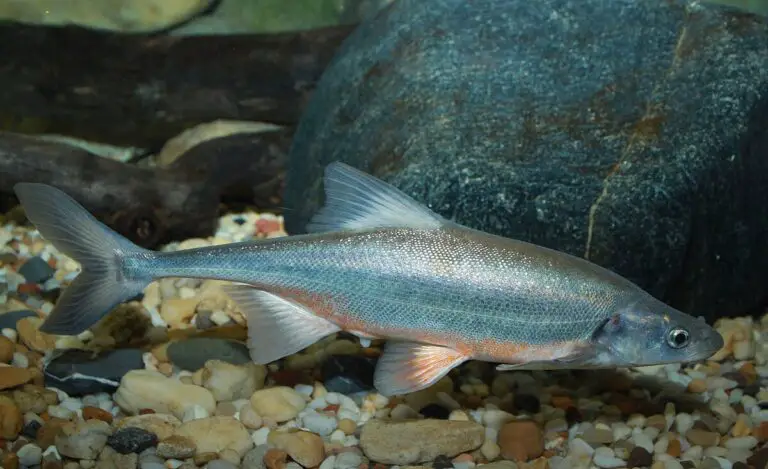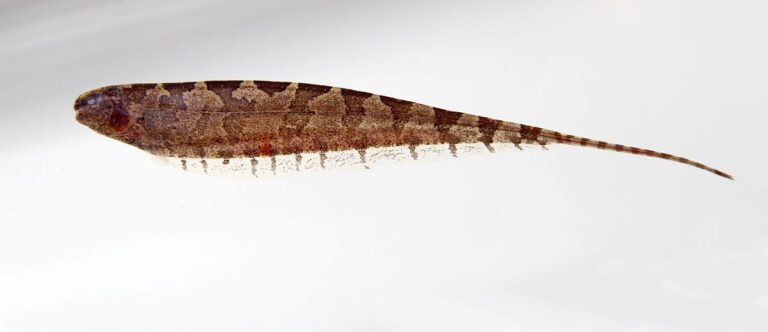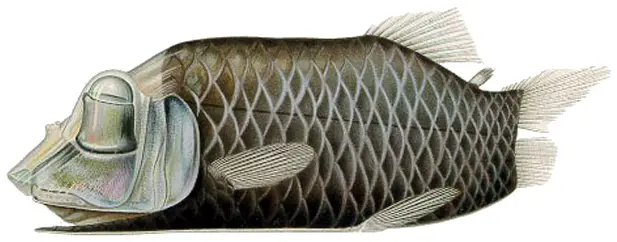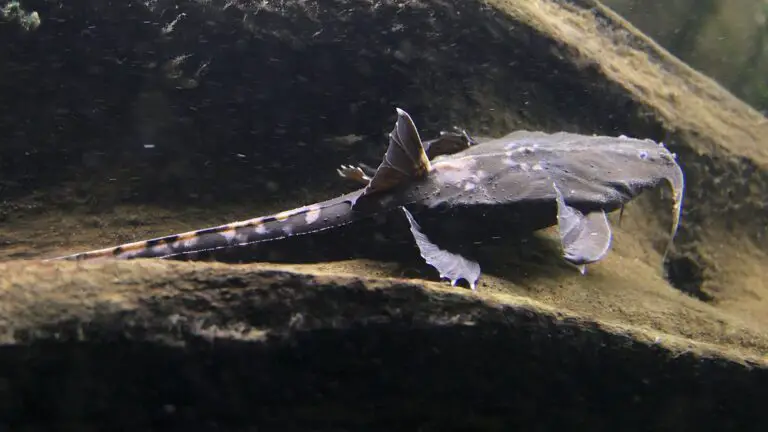Jellyfish
“Many jellyfish can produce their light.”
Scientific Classification
- Kingdom: Animalia
- Phylum: Cnidaria
- Class: Scyphozoa
- Order: Semaeostomeae
- Family: Cyaneidae
Conservation Status: Least Concern
Habitat: Jellyfish are primarily found in oceans.
Jellyfish Facts:
- Common Name: Jellyfish
- Scientific Name: Cnidaria
- Group Behavior: Group
- Habitat: All oceans on planet Earth
- Diet: Carnivore, prey includes small fish, plants, fish eggs, larvae, and other small marine creatures
- Favorite Food: Small fish, plants, fish eggs, larvae, other small marine creatures
- Predators: Sharks, birds, tuna, sea anemones
- Biggest Threats: Sharks, birds, tuna, sea anemones
- Most Distinctive Feature: Tentacles hanging from the body that aid in stinging
- Fun Fact: Many jellyfish can produce their own light
- Estimated Population Size: 900 million (as of 1990)
- Gestation Period: Hatches within one day
- Average Litter Size: 100
- Lifestyle: Group
- Physical Characteristics:
- Color: Yellow, Red, Blue, White, Green, Orange, Purple, Pink
- Skin Type: Smooth
- Top Speed: 5 mph
- Lifespan: Three to six months
- Weight: 20-400g (0.7-14oz)
- Length: 0.5 inches to 16 inches; some species can grow up to 7 feet
Jellyfish are fascinating creatures found in oceans worldwide, known for their translucent bodies and trailing tentacles used for capturing prey.
Jellyfish are ancient marine creatures that have inhabited oceans for millions of years. While generally non-aggressive, they are renowned for their stinging ability, which serves as their primary defense mechanism.
These creatures utilize their tentacles for hunting prey. Remarkably, jellyfish lack bones, a heart, and many other typical organs; instead, their bodies are predominantly composed of water.
With a lifespan typically spanning three to six months, jellyfish can reach sizes of up to 7 feet. Their longevity in Earth’s oceans underscores their adaptability and survival strategies in diverse marine environments.
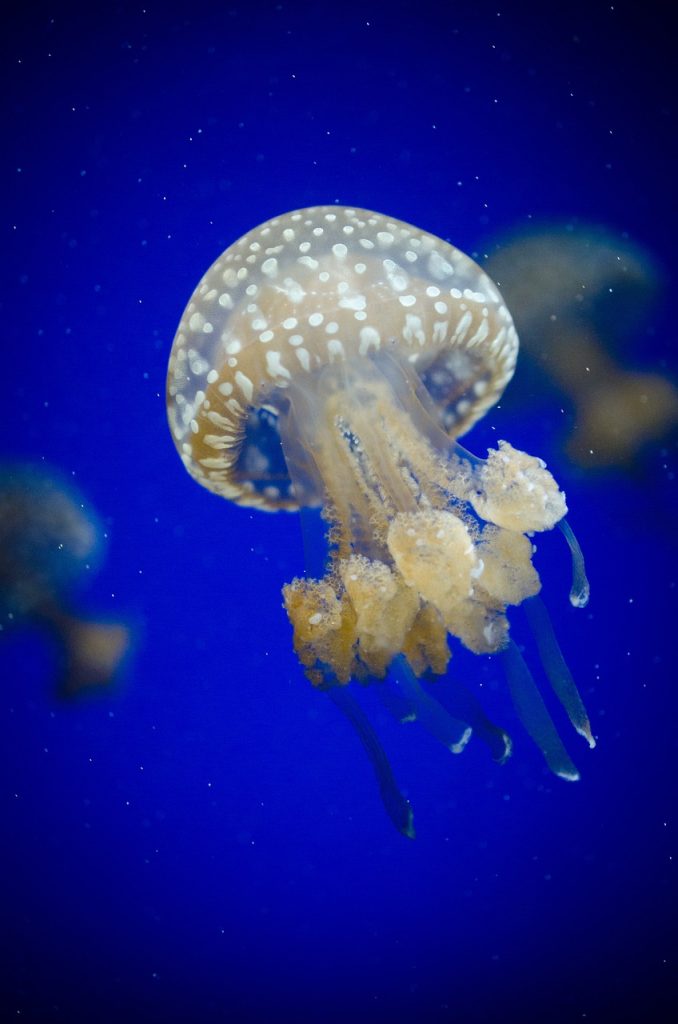
Do Jellyfish Have Brains?
Despite their captivating beauty, jellyfish lack a brain. Instead, their bodies feature a complex nervous system that coordinates all motor functions and sensory activities. This intricate network of neurons enables jellyfish to control muscle contractions, which in turn allows them to propel themselves through the water column. This unique adaptation showcases their remarkable ability to navigate and survive in their aquatic habitats without a centralized brain structure.
Incredible Jellyfish Facts!
- No brains, heart, or eyes: Jellyfish are composed mostly of water and lack brains, hearts, or eyes. Their body functions are controlled by a decentralized nervous system.
- Ancient beings: Jellyfish have existed for millions of years, making them ancient creatures that predate even dinosaurs.
- Bioluminescence: Many jellyfish species are bioluminescent, meaning they can produce their own light, adding to their mystical appearance in the ocean depths.
- Quick digestion: Jellyfish have a rapid digestion process, which helps them efficiently process their food and stay buoyant in water.
- Worldwide delicacies: Despite being preyed upon by various predators, jellyfish are also consumed by humans globally, highlighting their cultural significance and culinary appeal in certain regions.
These facts underscore the unique and intriguing characteristics of jellyfish as fascinating marine organisms.
Classification and Scientific Name
These creatures are known scientifically as Scyphozoa and fall under the kingdom Animalia and phylum Cnidaria. The term “Scyphozoa” originates from the Greek words “skuphos” and “zōion.” “Skuphos” translates to “drinking cup,” while “zōion” means “animal.” This name suggests that these animals resemble a cup or bowl shape, perhaps holding water. The phylum Cnidaria is also intriguing because its name comes from the modern Latin word “knidē,” which means “nettle.” This reflects the characteristic stinging cells, called cnidocytes, found in these animals like jellyfish.
As part of their classification, these fish belong to the sub-phylum Medusozoa and class Scyphozoa, which aligns with the scientific name for jellyfish. The term Medusozoa derives from the Ancient Greek Μέδουσα, originating from the concept of “rule over” (μέδω).
Evolution
Jellyfish are believed to have evolved from the phylum Cnidaria, a group that includes anemones and corals. They are thought to be among the first oceanic swimmers powered by muscles. Their origins trace back to the Precambrian Era, a time marked by significant ecological and geological changes that eventually led to the rapid diversification of animal life during the later Cambrian Era.
According to the prevailing theory, jellyfish underwent a transformation from polyps anchored to the ocean floor into free-swimming medusae equipped with stinging tentacles. This evolutionary adaptation likely contributed to their survival through numerous mass extinction events spanning over 500 million years.
An alternative view held by some scientists suggests that Cnidaria originally included a medusa life stage, setting them apart from sea anemones and corals, which predominantly exist as polyps.
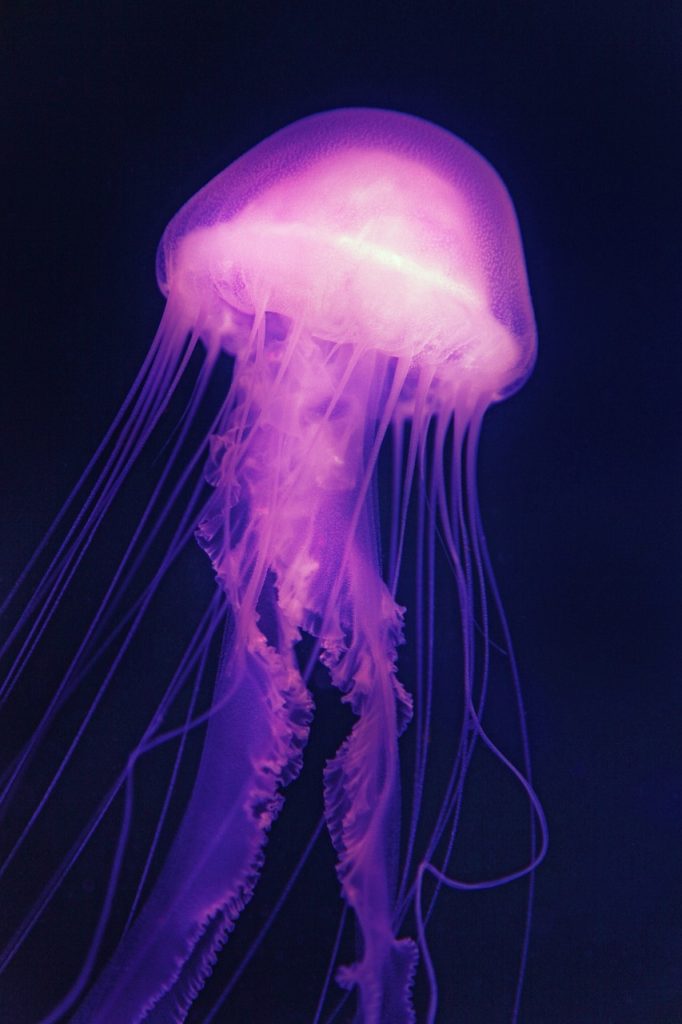
Species
Jellyfish comprise a diverse family of planktonic creatures, with scientists having identified over 4,000 species so far. Given the vastness of the oceans, experts believe this number represents only a fraction of the total species diversity underwater.
Despite their abundance worldwide, only around 70 species pose a threat to humans. Among the most dangerous are the Malo kingi and Chironex fleckeri, both belonging to the box jellyfish family, whose venom is potent enough to cause severe pain and even death.
Interestingly, some jellyfish species are kept as pets due to their inability to sting their owners. The moon jellyfish is the most common choice, typically living for about 15 months, although other species can live significantly longer.
In terms of collective nouns, a group of jellyfish is known as a swarm, smack, or bloom, reflecting their tendency to congregate in large numbers. These gatherings play crucial roles in marine ecosystems.
One particularly fascinating species is the Turritopsis dohrnii, often called the Immortal jellyfish. This small, transparent jellyfish has the remarkable ability to revert to earlier stages of its life cycle, essentially rejuvenating itself. This unique transformation allows the jellyfish to return to its polyp state, akin to its initial form as a fertilized egg settling on the seafloor, potentially extending its lifespan indefinitely under favorable conditions.
Appearance
Jellyfish exhibit a wide range of appearances, from transparent to vivid colors like yellow, blue, and pink. They are bioluminescent, capable of producing their own light.
Despite their complex appearance, jellyfish have relatively simple bodies. They lack bones, brains, hearts, or eyes. Their bodies are smooth, with tentacles that contain tiny stinging cells called nematocysts, which they use to capture prey.
Their mouths are located in the center of their bodies. Jellyfish sizes vary widely, typically ranging from 0.5 inches to about 7 feet in diameter and weighing up to 440 pounds.
The tentacles of jellyfish are critical for capturing prey. These tentacles are armed with microscopic stinging cells that are triggered when the jellyfish comes into contact with its target. The sting is used both for defense and to immobilize prey by paralyzing or stunning it.
While the sting can be painful and sometimes dangerous, it is rarely fatal to humans, except in the case of certain species like box jellyfish, which possess extremely potent venom. Overall, the primary function of jellyfish tentacles is to subdue prey and protect the jellyfish from potential threats in their aquatic environment.
Deadly Jellyfish
While some jellyfish species, like the moon jelly (Aurelia aurita), are relatively harmless, others pose significant danger, particularly those found in the Indo-Pacific region and around northern Australia.
The most lethal among them is the Australian box jellyfish, scientifically known as Chironex fleckeri. This jellyfish is the largest species within the box jellyfish family, easily identifiable by its tentacles that resemble shoelaces and can extend up to 10 feet in length, trailing from a pale blue, skull-shaped dome.
Like other venomous jellyfish, Chironex fleckeri’s tentacles are equipped with millions of nematocysts, which release venomous darts upon contact. The pain inflicted by its venom is described as comparable to that of a branding iron, and its sting can be fatal within minutes.
Interestingly, despite its deadly reputation, the Australian box jellyfish is a favored prey of turtles. Turtles possess thick skin that allows them to largely ignore the jellyfish’s stings, enabling them to feast on these jellyfish without much discomfort.
This interplay between predator and prey in the marine ecosystem highlights the adaptations and survival strategies evolved by both jellyfish and their predators over time.
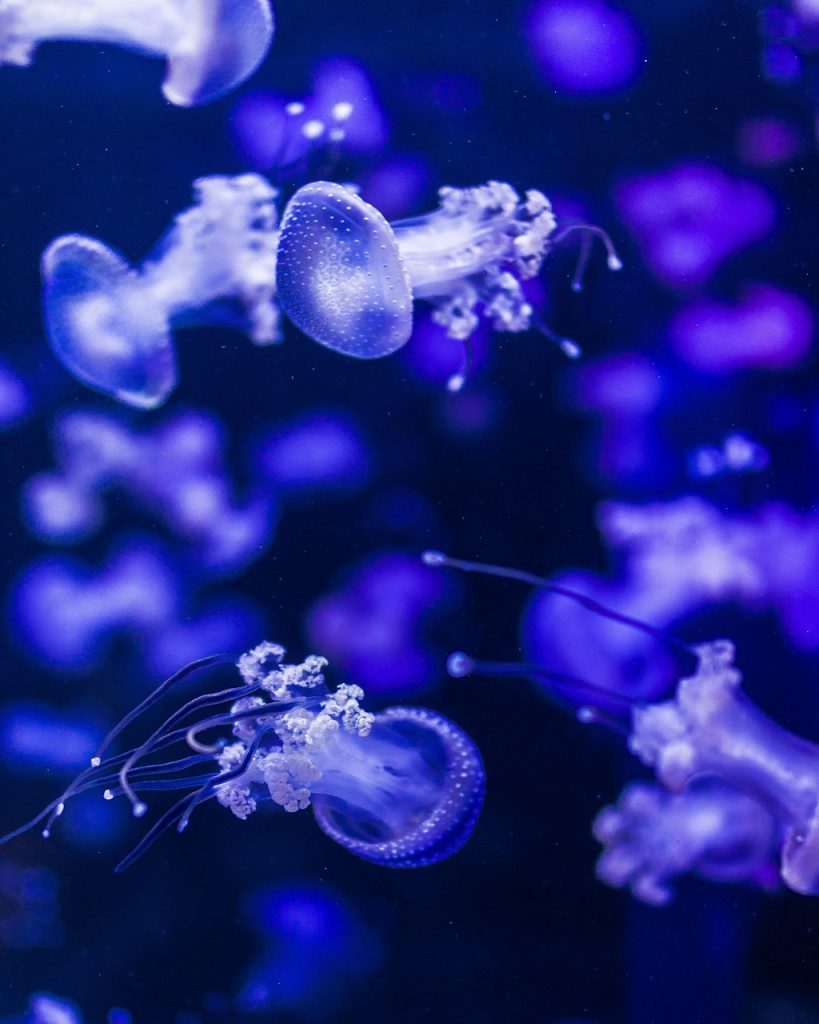
Distribution, Population, and Habitat
Jellyfish are ubiquitous creatures found in every ocean worldwide, adapting to diverse environments ranging from warm tropical waters to cold Arctic seas. They exhibit remarkable versatility, inhabiting both ocean depths and surface waters.
While their specific habitats vary, all jellyfish require saltwater to thrive. Their presence spans vast scales; for instance, as of 1990, the Black Sea alone housed an estimated 900 million tons of jellyfish.
Despite their adaptability, jellyfish face significant threats from pollution. Events such as oil spills and chemical dumping can harm them profoundly. These pollutants can penetrate their delicate skin, hindering their reproductive abilities. While pollution may not always cause immediate death, it often shortens their lifespans significantly.
The impact of pollution underscores the vulnerability of jellyfish populations, emphasizing the need for conservation efforts to mitigate environmental damage and preserve their habitats worldwide.
Predators and Prey
Jellyfish face threats from a variety of sea and land creatures, including predators like sea anemones, swordfish, sea turtles, tuna, and penguins. When jellyfish wash ashore, they are often consumed by foxes, birds, and other animals. Human activities also impact jellyfish populations; they are sometimes caught and considered a delicacy when cooked.
In terms of diet, jellyfish are opportunistic feeders, consuming plankton, small plants, fish larvae, crustaceans, and even fish eggs. They use their tentacles, armed with tiny sting cells called nematocysts, both for capturing prey and defending themselves. These stinging cells inject venom upon contact, causing pain, irritation, and in severe cases, whole-body illness. Certain jellyfish stings can be life-threatening, with the Australian box jellyfish known for delivering one of the most potent and painful stings in the world. Its venom is so intense that it can induce shock and potentially lead to drowning in victims.
These dynamics illustrate the complex interactions jellyfish have within marine ecosystems and the significant impact their presence, behaviors, and stings can have on both natural environments and human activities.
Reproduction and Lifespan
Jellyfish exhibit both sexual and asexual reproduction. Some species reproduce sexually, while others use asexual methods. In both processes, fertilized eggs develop into multicellular larvae called planulae, which eventually settle on the seafloor.
The lifespan of a jellyfish varies widely among species, with averages ranging from three to six months, though some individuals can survive up to two to three years. What’s unique about jellyfish is that they don’t undergo a typical aging process like many other animals. Instead of a natural death, they eventually settle on the seafloor where they contribute to the next generation of jellyfish through their DNA. Essentially, jellyfish continuously clone themselves, perpetuating their genetic lineage without experiencing a traditional death. This biological trait underscores their remarkable ability to adapt and persist in marine environments.
Jellyfish in Fishing and Cooking
Jellyfish are indeed harvested and enjoyed as food in various parts of the world. More than twelve species are considered edible and are prized for their texture and nutritional value. They are known to be a rich source of protein and fatty acids.
One popular way to prepare jellyfish is in a dish like sesame jellyfish. This recipe often includes ingredients such as soy sauce, vinegar, sesame oil, and sometimes chili oil. These flavors complement the unique texture of jellyfish, making it a delicacy appreciated for its taste and cultural significance in culinary traditions across different regions.
Classifications of Cnidaria
Certainly! Here’s an overview of the different classes of jellyfish within the phylum Cnidaria:
Scyphozoa: Known as “true jellyfish,” Scyphozoa encompasses approximately 200 species. These jellyfish typically have a bell or cup-shaped body and swim freely in marine environments. Some notable species include the Moon Jelly (Aurelia aurita), Barrel jellyfish (Rhizostoma pulmo), Cannonball jellyfish (Stomolophus meleagris), Cassiopea andromeda, Aurelia coerulea, Helmet jellyfish (Periphylla periphylla), and Lion’s Mane jellyfish (Cyanea capillata).
Hydrozoa: This diverse class contains around 700 species of jellyfish. Hydrozoans can be small, either transparent or pigmented, and are commonly found seasonally in coastal habitats from late spring to early fall. Some examples include the freshwater jellyfish (Craspedacusta sowerbyi), freshwater polyps (Hydra), Obelia, Portuguese man o’ war (Physalia physalis), chondrophores (Porpitidae), “air fern” (Sertularia argentea), and pink-hearted hydroids (Tubularia).
Cubozoa: Also known as box jellyfish, Cubozoa comprises about 50 species characterized by their box-like shape when viewed from above. They typically have well-developed eyes and their tentacles are often arranged in clusters. Stings from some species of box jellyfish are extremely painful and can be dangerous to humans. Examples include the Australian sea wasp (Chironex fleckeri), Carukia barnesi, and Malo kingi.
Staurozoa: Staurozoa, known as stalked jellyfish, are distinctive for their trumpet-shaped bodies. They grow upside-down compared to other jellyfish, with their tentacles projecting upwards and their stalk situated in the center of their umbrella. Examples include Haliclystus antarcticus, Manania handi, Lucernaria quadricornis, and Haliclystus octoradiatus.
These classes of jellyfish exhibit a wide range of adaptations and behaviors, contributing to their diversity and ecological roles in marine ecosystems. Each class has unique characteristics that distinguish them within the broader group of cnidarians.
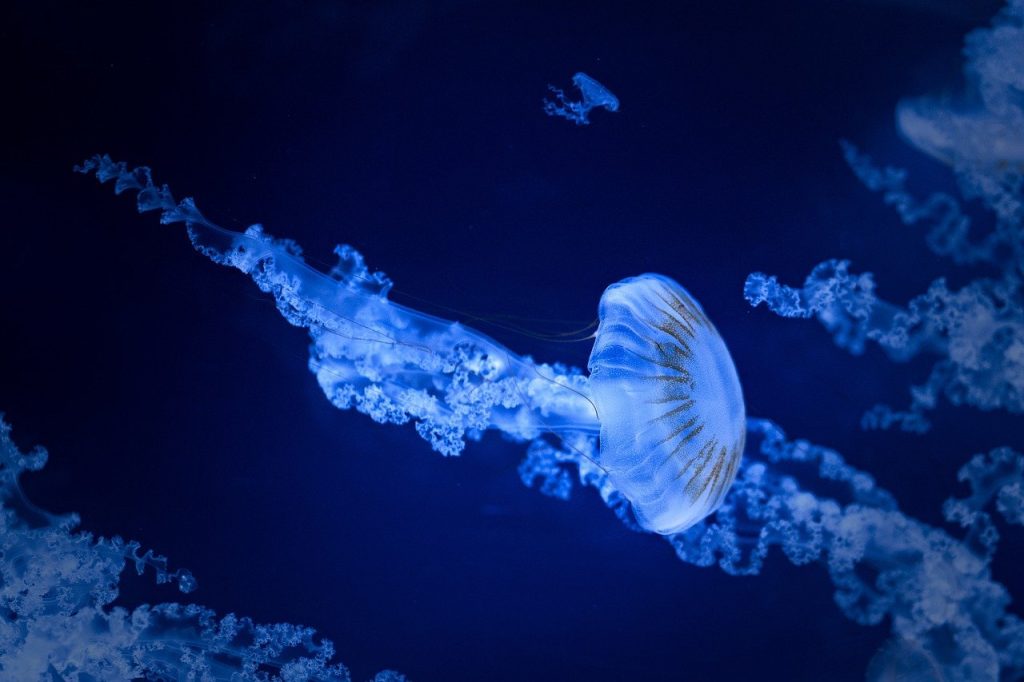
Types of True Jellyfish (Scyphozoa)
Moon jelly (Aurelia aurita)
- Commonly found in coastal waters worldwide, recognized by its translucent bell with four horseshoe-shaped gonads.
Cannonball jellyfish (Stomolophus meleagris)
- Known for its dome-shaped bell and found in warmer coastal waters, particularly in the Atlantic and Gulf of Mexico.
Rhopilema esculentum
- Also known as the “edible jellyfish,” commonly consumed in parts of Asia.
Barrel jellyfish (Rhizostoma pulmo)
- Large jellyfish species with a barrel-shaped bell and often found in the waters of the Mediterranean Sea and around the UK.
Lion’s mane jellyfish (Cyanea capillata)
- Known for its impressive mane-like tentacles and found in colder northern waters, including the Arctic and northern Atlantic.
Cassiopea
- Also known as the upside-down jellyfish, typically found in shallow coastal waters where it rests upside down on the seafloor.
Phacellophora camtschatica
- Known as the egg-yolk jellyfish due to its yellowish coloration, found in the northern Pacific Ocean.
Blue jellyfish (Cyanea lamarckii)
- Recognized by its blue coloration and found in the Atlantic Ocean, including waters around Europe.
Pelagia noctiluca
- Also known as the mauve stinger, recognized by its pinkish-purple coloration and found in warmer waters worldwide.
Nomura’s jellyfish (Nemopilema nomurai)
- Large jellyfish species found primarily in the waters of China, Japan, and Korea.
Cotylorhiza tuberculata
- Known as the Mediterranean jellyfish, characterized by its saucer-shaped bell and found in the Mediterranean Sea.
Chrysaora hysoscella
- Commonly known as the compass jellyfish, recognized by its brownish markings on the bell and found in European waters.
Jelly blubber (Catostylus mosaicus)
- Found in the waters of the Indo-Pacific region, recognized by its bell with distinctive markings.
Crown jellyfish (Netrostoma setouchina)
- Known for its crown-like appearance due to its extended oral arms.
Chrysaora
- A genus of jellyfish that includes several species such as Chrysaora fuscescens, Chrysaora melanaster, and Chrysaora quinquecirrha.
Stygiomedusa
- A genus of deep-sea jellyfish, known for its mysterious appearance in the deep ocean.
Semaeostomeae
- A suborder of jellyfish that includes various species found worldwide.
Spotted jelly (Mastigias papua)
- Known for its translucent bell with distinctive markings and found in the waters of the Indo-Pacific region.
Deepstaria
- A genus of deep-sea jellyfish known for its large, translucent bell.
Mawsonite
- A genus of jellyfish found in deep waters, named after the Antarctic explorer Sir Douglas Mawson.
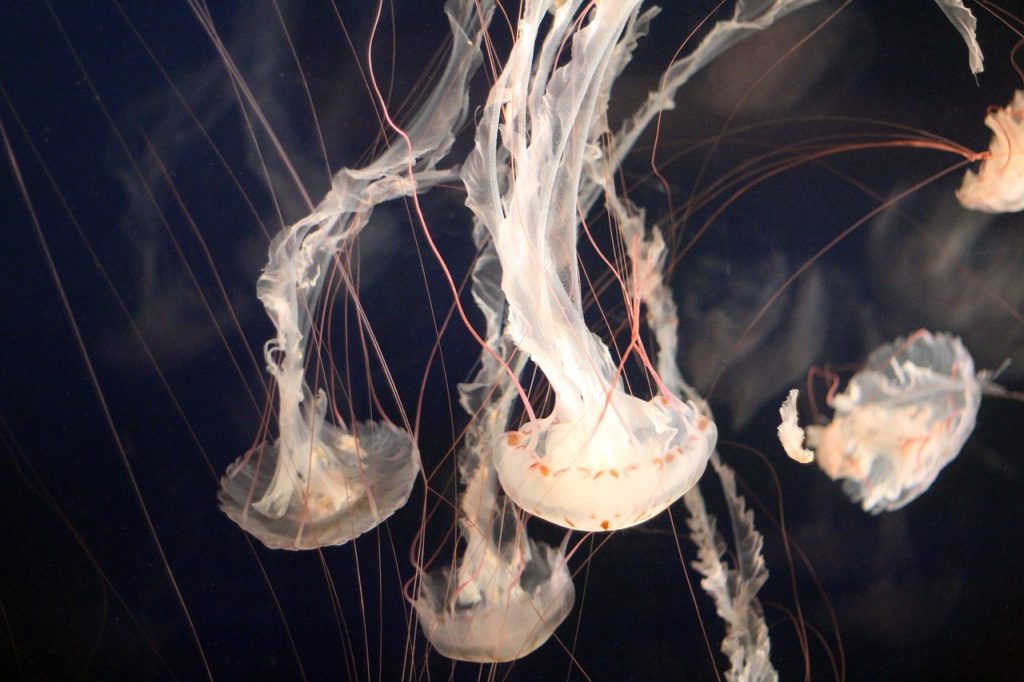
Coronamedusae
- A group of jellyfish characterized by their crown-like appearance.
These are some of the notable types of true jellyfish (Scyphozoa) encompassing various species, genera, and families within the order Scyphozoa. Each species often has unique characteristics that distinguish it from others in terms of appearance, habitat, and behavior.
Conclusion
Jellyfish, diverse and fascinating creatures belonging to the phylum Cnidaria, play crucial roles in marine ecosystems despite their simple anatomy. With a wide range of species adapting to diverse environments worldwide, from shallow coastal waters to the depths of the ocean, jellyfish serve as both predators and prey, influencing food webs and nutrient cycling. Their pulsating bells and stinging tentacles make them both captivating and sometimes hazardous to humans, yet their resilience in changing ocean conditions highlights their evolutionary adaptability. Studying jellyfish provides insights into marine biology, ecology, and even medical research, underscoring their significance in the intricate balance of our oceans.
Reference:
